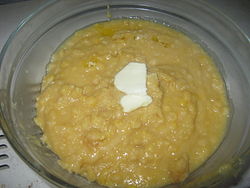Pease pudding
 Pea puree | |
| Alternative names | Pease pottage, pease porridge, pea and ham soup |
|---|---|
| Type | Pudding |
| Place of origin | England |
| Region or state | Northumbria |
| Main ingredients | Split yellow peas, water, salt, spices |
Pease pudding, also known as pease porridge, is a savoury pudding dish made of boiled legumes,[1] typically split yellow peas, with water, salt and spices, and often cooked with a bacon or ham joint. A common dish in the north-east of England, it is consumed to a lesser extent in the rest of Britain. In Newfoundland, it retains its traditional name as part of the customary Jiggs dinner. In non-English speaking countries, similar dishes exist under different names.
Dish[edit]

Pease pudding is typically thick,[2] somewhat similar in texture to (but perhaps a little more solid than) hummus, and is light yellow in colour, with a mild taste. Pease pudding is traditionally produced in England, especially in the industrial North Eastern areas including South Shields, and on down to Darlington on the North Yorkshire border. It is often served with ham or bacon, beetroot and stottie cakes. It is also a key ingredient in the classic saveloy dip. In Southern England, it is usually served with faggots. Also in southern England is the small village of Pease Pottage which, according to tradition, gets its name from serving pease pottage to convicts either on their way from London to the South Coast, or from East Grinstead to Horsham.
Peasemeal brose, also known as brosemeal, is a traditional breakfast dish in the north of Scotland. It is made in the traditional way and usually eaten with butter, and either salt or honey.
In parts of the Midlands[citation needed], it replaces mushy peas as a traditional accompaniment to fish and chips, although the distinction is largely the name and tendency for mushy peas to be green. In both cases, the starchy "field peas" used are harvested dry, as opposed to "sweet peas", which are the same species harvested fresh.
Etymology[edit]
In Middle English, pease was a mass noun, used in the same way as flour or oatmeal. Later taken to be a plural form, the modern singular pea and its plural peas derive from this, in a process known as back-formation.[3]
Regional variations[edit]
The dish is a traditional part of Jiggs dinner in Newfoundland, Canada.[4]
In German-speaking countries, pease pudding is known under the name Erbspüree or Erbsenpüree. Alternative regional names are Erbsbrei or Erbsmus. It is especially widespread in the traditional cuisine of the German capital Berlin. The best-known German dish which is traditionally served with pease pudding is Eisbein. A similar dish with ham hock, karka, is served in Lithuania.
In the Netherlands, pea soup is called snert, or erwtensoep. It is cooked with dried split peas (yellow, or green), with chopped onions and bay leaf, and a smoked pork sausage, often Polish, which is then sliced, and served with the soup.
Traditional Russian cuisine has several pea-based dishes, including pease pudding/puree/soups known as gorohovaya kasha (Russian: гороховая каша) or goroshnitsa (Russian: горошница).[5]
In Beijing cuisine, wandouhuang (豌豆黄) is a sweetened and chilled pease pudding made with yellow split peas or shelled mung beans, sometimes flavoured with sweet osmanthus blossoms and dates. A refined version of this snack is said to have been a favourite of Empress Dowager Cixi.
In Greek cuisine, a similar dish is called fava (Φάβα). Despite the name, it is usually made from yellow split peas, not broad beans. The mashed peas are usually drizzled with olive oil and topped with chopped raw onions.[6]
Recipe[edit]
Generally, recipes for pease pudding involve steeping soaked split yellow peas in stock (traditionally ham hock stock) and cooking them for around 40 minutes. The resulting mush is then blended with other ingredients, which depend on the variation. The oldest known written recipe for something similar to pease pudding involves saffron, nutmeg and a little cinnamon in the blending process;[citation needed] modern recipes sometimes beat in an egg at this point to act as an extra binding agent.
In popular culture[edit]
Pease pudding is featured in a nursery rhyme, "Pease Porridge Hot".[7]
The song "Food, Glorious Food" from the 1960s West End and Broadway musical (and 1968 film) Oliver! has a lyric extolling pease pudding.
In The Princess and the Goblin, Curdie takes bread and pease pudding with him for sustenance when he goes to spy on the King's house.[8]
See also[edit]
References[edit]
- ^ Roundell, Mrs Charles (1898). Mrs. Roundell's Practical Cookery Book: With Many Family Recipes Hitherto Unpublished. Bickers. p. 226.
Pease pudding.
- Jane Grigson (2007). Jane Grigson's Vegetable Book. U of Nebraska Press. pp. 375–. ISBN 978-0-8032-5994-2. - ^ McElhatton, Heather (13 October 2009). Pretty Little Mistakes: A Do-Over Novel. Harper Collins. p. 357. ISBN 9780061857027.
- Popular Science. Bonnier Corporation. June 1885 – via Google Books. - ^ Safire, William (25 September 1988). "ON LANGUAGE; Eat Your Peas". The New York Times. ISSN 0362-4331. Retrieved 27 January 2024.
- ^ "Pease Pudding Recipe - Genius Kitchen". Retrieved 19 March 2018.
- ^ Maria Bunina (10 April 2019). "7 vintage Russian pea dishes every vegetarian should know". Russia Beyond. Retrieved 17 March 2021.
- Alissa Timoshkina (3 February 2020). "Goroshnitsa Pea Soup". Retrieved 17 March 2021. - ^ "Fava: Purée of Yellow Split Peas". About. Archived from the original on 13 May 2013. Retrieved 12 August 2013.[unreliable source?]
- ^ I. Opie and P. Opie (1951). The Oxford Dictionary of Nursery Rhymes (2nd [1997] ed.). Oxford University Press. p. 345.
- Notes and Queries. Oxford University Press. 1870 – via Google Books. - ^ MacDonald, George (1872). "25". The Princess and the Goblin. p. 84. Retrieved 16 June 2016.
